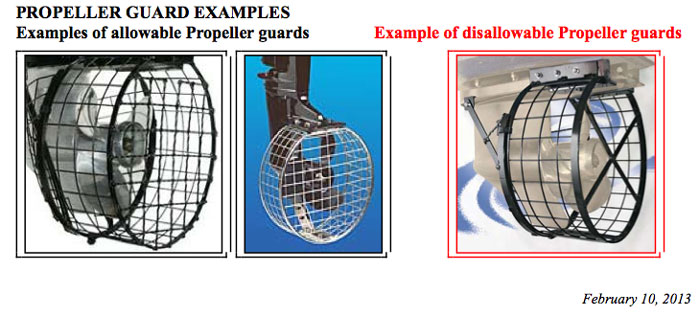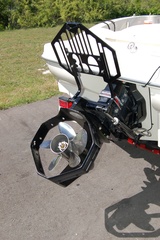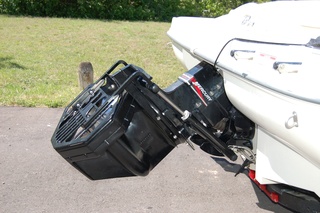Propeller Guards Required by U.S. Masters Swimming Open Water Events
U.S. Masters Swimming (USMS) was facing skyrocketing insurance costs for open water swimming events. Costs have risen so high that many members would no longer be able to compete. As a part of the changes, boats will now be required to have propeller guards.
Nadine Day, USMS President, says the increased insurance premium was mostly related to open water swims. Their insurance premium included a $135,000 charge for covering 75 sanctioned open water events at $1800 per event. Any additional open water events would be billed at $1800 per event.
In addition, several more restrictions were placed on open water events making them more costly and complicated to hold. USMS is now hiring new Open Water Compliance Coordinators to help meet those requirements.
USMS has decided to fund $800 of the per event surcharge themselves, pass $1000 on to the Local Masters Swimming Subcommittees who can then decide how much of that $1,000 to pass on to the event host.
They note that solo swims (like one person swimming across the Catalina Channel) were previously considered sanctioned events. Now they must pay the total $1800 insurance fee. Similarly, if a large event elects to host additional open water swims, that event must come up with the $1800 for each one of those swims.
USMS now has three new open water swimming guidelines:
- Each boat must provide a certificate of insurance of $1 million per occurrence and $2 million aggregate listing USMS and others as covered.
- Each boat operator must provide proof of insurance.
- All boats supporting the event must have a propeller guard. The Event Director is to inspect all boats prior to the event.
World Open Water Swimming Association (WOWSA) coverage of the changes reports they think guards are a good idea, they have long been required by some of the best open water races in Canada, but FINA (the international swimming organization) executives had previously rejected them.
We briefly visited with a few folks in the last few months that were working on some of these changes and other water safety measures for open water swimming.
I mentioned the need to decide if they wanted guards that provided front and side protection or guards that provided all around protection (including entry from the rear).
US Masters Swimming describes the new rules in their 20 February 2013 post, Open Water Events and USMS Sanctions.
I noticed several articles about the recent changes include a photo of Prop Guard Marine’s prop guard (concentrical rings but open to the rear). As we searched for any definitions or requirements of propeller guards I found the minutes of USMS’s January 29, 2013 meeting.
A portion of those minutes are reproduced below:
From USMS Minutes 29 January 2013
Sanction Open Water Task Force report to the BOD
a. The task force has been working with the Long Distance, Open Water and Finance committees, the national office and other subject matter experts to provide the Board with recommendations on addressing the issues surrounding increased liability insurance costs and requirements of insurance. The task force is asking the board to take action on the safety and administrative recommendations at this meeting to defer action on the fees recommendation until the February 8th-10th board meeting
i. The Board MSA the following Safety Recommendations:
1. All propeller driven watercraft used in conjunction with the sanctioned open water events must have a propeller guard(s) installed for the duration of the event.
2. Exceptions:
a. Boats owned and operated by Coast Guard, police, fire and rescue, or other government agencies
b. Boats at anchor from start to finish of the sanctioned event with engine(s) off, while any swimmer is in the water
c. Boats with propellers fore of the rudder (e.g. in-board motors), provided:
i. These boats do not run directly on the designated swim course,
ii. For events requiring personal escort craft, water craft with in-board motors may be allowed on the course provided their engines are off when any swimmer is within 20 feet of the propeller and during relay exchanges. For feedings the swimmer may approach within 5 feet of the bow or side of boat with engines engaged.
3. Propeller guards must be of a design that protects swimmers from propeller strikes.
USMS Minutes Are Codified And Adopted
In the minutes above, we see them facing some of the definition challenges faced by others. They conclude with “Propeller Guard must be of a design that protects swimmers from propeller strikes.”
With further searching, we were able to find a 10 February 2013 document titled Part 1: Open Water Sanction Guidelines providing the new details for sanctioned open water swimming events. It codifies the details supplied in the minutes above. The final page of those sanctions provides graphics identifying allowable propeller guards and an example of one that is disallowable. It also notes the Local Masters Swimming Committee Evaluator and Event Referee must inspect the boats for propeller guards the day of the event, and document that inspection with a written report and photographs of their visual inspection conducted the morning of the event.
The propeller guard examples show a MariTech SwimGuard and a Adventure Marine “Propeller Safety Guard” as acceptable. They show MariTech’s SwimGuard Pro with its cross bars to the rear for higher speed operation as disallowed.
Which Propeller Guards Are Allowable?
No reasons are provided for disallowing the SwimGuard Pro. We suspect they disallowed it due to its openness to the rear.
We suggest USMS better define allowable and disallowable propeller guards. If they are primarily concerned about entry to the propeller, they might use a ball on a stick like Australia did for the surf lifesaving prop guards. If you can stick a metal sphere of diameter “x” through the screen anywhere, it fails.
Or they could show a range of photos of specific guards being ruled as approved or not.
At the moment, we are not sure if Guy Taylor’s 3PO Navigator propeller guard with its pivoting rear shield would meet their requirements or not. The guard provides coverage to the side and rear. USMS may or may not think it provides coverage to the front.
As we continued to search for any more guidance on which guards might or might not be accepted, we found a reference to a January 10, 2013 pdf document in the USMS online forum. That document is no longer there, but Google still has a copy of it. Note it is NOT part of the official sanctioning rules. It opens with “Propeller guards must be of a design that protects the vital organs of swimmers from propeller strikes from the sides and stern of the propeller.” Then it shows images of four disallowed propeller guards. Those images are the MariTech SwimGuard Pro (same image as used in the final example show on this page with the cross to the rear), Adventure Marine’s Propeller Line Guard (a ring guard), a orange Prop Guard Marine Prop Guard (concentric rings open to the rear), and a white Prop Guard Marine Prop Guard (concentric rings open to the rear). While this document did not make it into the final release, it provides some insight into their thinking.
We note the sanctioning guidelines still allow Coast Guard, local fire department, and other government vessels to be used at the events without guards. We encourage officials to try to keep those boats in the background and use the boats with guards out near the swimmers.
Conclusion
We commend USMS for taking actions to improve open water swimming events and encourage other open water events to do the same. We have recorded too many propeller accidents at open water events (swimming, canoeing, sailing) in recent years.


